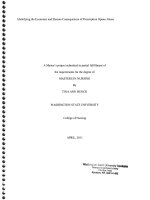Assamese monkeys in Nagarjun forest of Shivapuri Nagarjun national park, Nepal
Bạn đang xem bản rút gọn của tài liệu. Xem và tải ngay bản đầy đủ của tài liệu tại đây (352.68 KB, 10 trang )
ASSAMESE MONKEYS IN NAGARJUN FOREST
OF SHIVAPURI NAGARJUN NATIONAL PARK,
NEPAL
Mukesh K Chalise
Hideshi Ogawa
Bishnu Pandey
ABSTRACT
The population distribution of Assamese monkey Macaca assamensis
were studied in Nagarjun forest of Shivapuri Nagarjun National Park, Nepal and
data collected during Dec. 2013 and January 2014, by scan sampling methods
along with transect walk through forest trails and ring-road of forest.. Seven
bisexual troops were observed in subtropical/lower temperate forest of Nagarjun
forest especially around Raniban forest area. The observed smallest troop was
with 9 individuals while the largest troop had 37 (41) individuals of different age.
The average troop size is 20.57. Out of three broad age groups adults were
56.31% and immature 43.06% while infant alone were 18.06%. The sex ratio
between male and female was 1:1.34. Plant usage for feeding and resting were
also enumerated. Nagarjun forest troops use mostly tall trees for the night halts
and resting in day time.
Key words: Assamese monkey, population, floral usage, Nagarjun, Nepal.
INTRODUCTION
Macaca assamensis is explored patchily in Nepal. Its status and
distribution within the Makalu-Barun area is documented partially and some
information is available from Langtang area. The legally protected animal
Assamese monkey (Macaca assamensis) was first recorded in 1985 in Shivapuri
Nagarjun National Park and thereafter remained unknown longtime (Wada, 2005;
Chalise et al., 2005).
It is perhaps one of the less common primate species in Nepal belonging
to the genus Macaca. It belongs to the sinica-troop together with Macaca sinica,
Macaca radiata, and Macaca thibetana. Macaca assamensis inhabits the foothills
of the Himalayas and adjoining mountain ranges from west-central Nepal
eastward through Sikkim, northern West Bengal, Bhutan, Arunachal Pradesh,
Nagaland and in northern and eastern Burma, southern China, and the northern
part of the south-east Asia. An estimated 20,300 of these animals inhabit
Indochinese protected areas. They are killed for crop pest control measures and
have been included on the list of endangered species in this region and protected
species of Nepal. (Chalise, 1999, 2003).
The local vernacular names of the Assamese monkeys are Kalo Bandar,
Pahare Bandar, Pupa, Timnyau, and KalaGanda. Considered distinct and likely
endemic to Nepal, they are referred to as the “Nepal Population” by CAMP
Dr. Chalise is an Associate Professor at Central Dept of Zoology, T.U., Kirtipur, Kathmandu.
Nepal.
182 ASSAMESE MONKEYS IN NAGARJUN FOREST...
(2003), as they are awaiting taxonomic revision (Sanjay et al. 2003; Chalise,
2008). It is also possible that within Nepal two forms may occur with a distinct
difference found between the higher elevation and lower elevation populations
between 380 and 2,350 m (Chalise, 2003a, 2008a). At present they are trooped
within the larger Assamese metapopulation and are classified as Near Threatened
by the IUCN. Assamese monkeys are similar to rhesus in a generalized
“macaque” way, but locals describe them as “missal” or mixed for their color
variation within troops (Chalise, 2013a, b).
Assamese monkeys tend to be larger and heavier than rhesus, with males
and females weighing more than 12 kg on average, and having a head and body
length greater than 60 cm. This population is different from Assamese monkeys
described so far from this region Asia (Roonwal and Mohnot, 1977; Fooden,
1989, Kawamoto et al., 2006, Zhao et al., 2011; Timmins et al., 2013) in respect
to the head-body length, tail length, T/HB ratio, body weight and fur coloration
and its distribution in Nepal.
Therefore, Socio-ecology and population distribution of this endangered
and protected monkey species of Nepal could be of great importance for the
purpose of species conservation and its management (Chalise, 2000, 2003, 2005).
ECOLOGY AND BEHAVIOR
Assamese monkeys live primarily in subtropical broadleaf-evergreen forests,
and to a lesser extent, mixed deciduous and bamboo forest utilizing many types of
forest vegetation from semi-deciduous mixed wet to tropical dry deciduous forest,
from monsoon to tropical evergreen Montana forest. They spend a great deal of time
in the high canopy and are rarely seen on the ground. Adult males tolerate to young
males and infants even hug sometime and groom briefly. Estrus female has sexual
swellings on the base of tail. Such cases are not recorded in rhesus. The swelling
looks like a blackish-brown protruded moist organ. Some people mistook it as a
septic. The infants are born during spring mostly but in late winter too. Infants are
much darker in fur coloration (Chalise, 2010).
Assamese monkeys inhabit in the mountains and hills along the
Himalayas. Like rhesus, they are flexible in habitat types in Nepal from river
basins to subtropical hills of Sal forests, mixed deciduous forest, temperate
broadleaved forest with rocky outcrops, and along the steep sloped forests along
rivers above altitude. Assamese monkeys of Nepal are diurnal animal found along
the hills, valleys and upland river basin along the east-west mountainous range
with diversified ecological zones. They are found in riverside hill-Sal forest area
to mixed deciduous and evergreen forest of Schima-Castonopsis, ElaeocarpusMacaranga forests in mid-hills and Quercus-Pine-Rhododendron forest of high
mountains. They are easily located in the remote mountain villages along the
marginal plots of agricultural lands. They are not recorded from Tarai plain and
high snowy mountains and in human settlements (Chalise, 2013a, b).
Assamese monkeys are shy, timid and less aggressive to human beings
in comparison to rhesus monkey. They are arboreal, terrestrial and omnivorous
animals with multi-male and multi-female social troops. They come to the ground
for easier and safe movement in the dense undergrowth from the tree middle
TRIBHUVAN UNIVERSITY JOURNAL, VOLUME. XXVIII, NUMBERS 1-2, DEC. 2013
183
canopy. They are mostly seen doing their social and other activities in the ground
with sluggish movement. They predominantly leaf eater but will feed on petiole,
gum, shoot, flower, fruits, seeds, bark and caterpillar while they do long foraging
activities to find young sprout of grass, aquatic herbs and their pith, aquatic
insects and larva, climb hanging greenish rocks to lick and eat a special type of
ground soil. They raid crops in hills of Nepal mainly for maize, rice, wheat,
millets and fruits. Astonishingly, they dig out potatoes, yam and sweet potatoes
from the ground and uproot the new maize seedling to eat the seed. They raid not
only banana but also rhizome of cardamom in the orchard farm of east Nepal. In
the off-season, they come to nearby tree grooves of village and hide until human
activities and when they feel secure, skillfully raid dry maize comb from
courtyard storage (Chalise, 1997, 1999, 2003).
They have sub-troops of close kith and kin and stay closely during
foraging, grooming and in night-rest in a troop. It is observed that adult females,
their infants and even male stay in body contact. In winter morning, to get
warmth they stay in sub-troops for longer period near night halt site and start
daily activities after sunshine in their part. During summer, they start their daily
activities earlier. The night halt sites are in rocky outcrops inaccessible by other
animals, which is visible blackish leakage by their night toileting. They reach
their by a slow and creeping walk through the bare rocks, sometime using only
hands. The species seems less quarrelsome than rhesus monkey. The recorded
troop size is 5 to 36 individuals in Langtang area while 7 to 50 individuals in
Makalu area. The total counted population revealed that there are more than 200
Assamese in Tamku sector of Makalu-Barun and same amount in Dhunche–Sebru
area of Langtang. Scattered population along the Melamchi River Helambu,
Tamor River around Mulghat, Ramdi area of KaliGandaki River and Kimni of
Acham are recorded, (Chalise, 2000; Chalise et al., 2001, 2005).
Recently it was confirmed that there are a number of troops around Nepal
and a total of 1,099 individuals Assamese in 51 troops recorded that were scattered in
Mid-hills along the Warm Temperate Monsoon and Cool Temperate Monsoon area
ranging from 1,000 to 3,000 m asl (Chalise, 2013a). In reference to the Shivapuri
Nagarjun National Park, it was published that the assamese troop size in the park was
23.71 in average with the standard deviation of 9.92 (Chalise et al 2013). In this study,
we further explored and found the adding in the population and habitat of M.
assamensis in Nagarjun forest especially in Raniban area.
METHODS
Study Area: Shivapuri Nagarjun National Park (SNNP) covers 159
square kilometers area and is located between 27°45’to 27°52’N and 85°15’ to
85°30’ E with two isolated islands forest Shivapuri and Nagarjun. Nagarjun lies
adjacent to Kathmandu city while Shivapuri is of 4 km distance to North. The
government of Nepal has declared the Shivapuri Watershed and Wildlife Reserve
as a national park in 2002 and the Nagarjun forest area has been annexed in 2009
AD (SNNP, 2010). The Shivapuri Nagarjun (1000-2732 masl) is the true
representation of the mid-hills in the protected area system of Nepal. The park
lies in the transition zone between sub-tropical to temperate regions with 1250
species of flowering plants. The floral composition park has been categorized into
184 ASSAMESE MONKEYS IN NAGARJUN FOREST...
four types viz. i) Lower mixed hardwood forests, ii) Chirpine forests, iii) Oak
forests, and iv) Upper mixed hardwood forests. The major plant species found are
Schima wallichii, Castonopsis indica, Pinus roxburghii, Myrica esculenta, Pyrus
pasia, Rhododendron arboreum, Juglans regia and Quercus sp. (SNNP, 2010).
Park record shows that it is supporting a number of animals of ecological
significance. SNNP provides shelter to 21 species of mammals (excluding rodents
and bats); clouded leopard Neofelis nebulosa, common leopard Panthera pardus,
leopard cat Felis bengalensis, jungle cat Felis chaus, pangolin Manis sp, rhesus
monkey Macaca mulata, barking deer Muntiacus muntjack, wild boar Sus scrofa
as well as assamese monkey Macaca assamensis, Himalayan black bear Ursus
thibetanus and other prey species. The park is important bird areas (IBAs) with
over 311 species of birds have been recorded. There are more than 102 species of
butterflies (Pandey, 2010; SNNP, 2010). It is estimated that more than 200
Rhesus monkeys inhabit around SNNP and with a maximum number of 64
individuals in a troop of Sundarijal (Chalise 2013a; Chalise et al., 2013).
OBSERVATION
The study areas were surveyed walking along Jamacho Road and also
the forest trail taken it as the transect line. After several visits to different spots,
areas with primate availability were selected as "focal areas". Such focal areas
were frequently visited on foot and the troop was studied. The focal troop
members were classified according to age and sex (Chalise, 1997). The duration
of any behavior and activities were also recorded on the protocol papers with the
help of binocular and watch. The individual counting and identification of troops
were repeated several times in one observation session. The data obtained from
this procedure gave insight for the determination of average troop size,
composition and social structure of species. For the behavioral observations,
continuous recording (or all occurrences recording) technique was used (Altman
1974; Martin and Bateson 1993). Diurnal activities and population census were
carried out 7:30 AM to 4.30:00 PM covering more than 80 hours by three
observers simultaneously.
RESULTS
POPULATION
The troops from Nagarjun forest were observed on south-Eastern slope
of mountain range while Sanagaun-Mudkhu troop was found on North-Western
slopes. Fulbari Gate troop was found Eastern slope and the Raniban troop was
found on Southern slopes (Fig. 1).
185
TRIBHUVAN UNIVERS
SITY JOURNAL, VOLUME. XXVIII, NUMBERS 1-2, DEC. 2013
Fig. 1: Nagarjun forest
f
site and assamese locations in SNNP, Kathmanddu Nepal,
2013/14.
All the trroops are found confined around the park bounddary and
frequently interactinng with crop-field of nearby villages. In Nagarjun foorest area
habitat sharing witth rhesus was common and frequent conflict was observed.
o
Interview with local park staff and security personnel revealed the possibbilities of
Assamese monkeys in the forests around Jamacho Gompa-Aindanda areaa too.
Table 1: Composittion of assamese monkeys in Raniban periphery of Nagarjun
N
forest, SNN
NP.
Area
Lat/Long
Mature
Male Female
Army barrack
8
N27°44’29.0”
E85°17’44.1”; 1419 m;
Cross road of army gate
g
2
N27°44’27.6”E85°17’5
1.8”1355 m;
4
Small subtroop
N27°44’45.5”
E85°17’47.4”; 1345 m;
Raniban Post aroundd
3
27°44.548N 85°17.3347E
Helipad All male trroop 5
27°44.508N 85°17.6600E
Simpane Raniban
8
27°44.535N 85°16.7789E
2
Ichangu
27°73284N85°270877E
Sanagaun
3
27°76300N85°253299E
Total
35
Age wise total an
nd
averagge
13
5
3
4
1
6
6
10
Total Poossibility
1
4
14
41
23
9
4
19
22
5
5
8
4
31
31
4
3
3
12
12
5
6
3
17
17
144
151
47
82
9.11
Immature
Juvenile
Infant
Male Female Male Female
3
5
3
5
37
36
26
62
8.85
20.57 1511/6=25.16
186 ASSAMESE MONKEYS IN NAGARJUN FOREST...
The recent census (December/Jan, 2013/14) revealed that there were
more than 176 assamese monkey individuals in the study area (Table 1). Among
them 144 individuals were age-wise categorized while immature were not fully
identified to sex-wise. The mature individuals counted were 82 (56.9%) while
immature were 62 (43.1%) individuals. Along Aindanda Sikaripost (27°74369N
85°24733E) area, we could figure out the total individual (20 to 25) only in a troop.
There were no single male but a troop of all male was identified in Raniban area.
Two troops of rhesus were found with the habitat of assamese. They
were found in the periphery of army barrack and water pool area. During both
species interaction assamese seemed reluctant to conflict with rhesus troop even
not with a single male. However, rhesus male tried several time to encroach
assamese foraging area.
Out of 51 plant species recorded during the 10 meter scan sampling of
assamese observation, 11 plant species are identified as the food plants during
this short study for winter season (Table 2). However there are more than 47
species that are known to be the food plants in other season. These food plant
species are also use as resting and night halt trees. There are no any rocky
outcrops or sloppy terrain in the area which can be the night halt site for them as
indicated in other habitat of assamese monkeys in Nepal, they rely on the tall tree
tops or middle canopy for night rest. In this area also they utilized the cattle’s
poisonous plant such as Bhalayo and Siundi, which secrete the alkaloids and at
least causing allergy to the harvesters.
Table 2: Plants and their usage by assamese around Raniban area, SNNP,
2013/14.
Nepali Name
1.
2.
3.
4.
5.
6.
7.
8.
9.
10.
11.
12.
13.
14.
15.
16.
Aijeru
Amala
Angeri
Arkhaulo
Bakhre ghas
Banjh
Bhalayo
Bilaune
Chilaune
Chutro
Dhairo
Dhale katus
Firfire
Gayo
Gogan
Hade bayer
Scientific Name
Loranthus sp.
Phyllanthus emblica
Lyonia ovalifolia
Lithocarpus sp.
Reinwardtia indica
Quercus lanuginosa
Semecarpus anacardium
Maesa chisia
Schima wallichii
Berberies aristata
Woodfordia fructicosa
Castonopsis indica
Acer oblongum
Budleja asiatica
Saurauia napaulensis
Zizyphus mauritiana
Use for the
Plant used in
Winter 2013/14 other season
Unknown
Rest
Unknown
Unknown
Food
Unknown
Unknown
Food
Food and Rest
Unknown
Unknown
Rest
Unknown
Unknown
Unknown
Food
Food
Food
Food
Food
Food
Food and rest
Food
Food
Food and rest
Food
Food
Food and rest
Food and rest
Food
Food
Food
TRIBHUVAN UNIVERSITY JOURNAL, VOLUME. XXVIII, NUMBERS 1-2, DEC. 2013
17.
18.
19.
20.
21.
22.
23.
24.
25.
26.
27.
28.
Hakulal
Jamun
Jhinganu
Kafal
Kalikath
Kalo siris
Kalo tindu
Kavro
Khanyu
Koiralo
Kutmero
Laliguras
29.
30.
31.
32.
33.
Lankuri
Lapsi
Mahuwa
Mallato
Musure
katus
Okhar
Paheli
Paiyun
Pangra
Patle katus
Pipal
Ranisalla
Saur
Setikath
Seto siris
Simal
Siundi
Tejpat
Tree fern
Uttis
Unknown 2
Kukhure
Gajali
Paniyor
34.
35.
36.
37.
38.
39.
40.
41.
42.
43.
44.
45.
46.
47.
48.
49.
50.
51.
52.
187
Symplocus sumuntia
Syzygium cumini
Eurya acuminate
Myrica esculanta
Myrsine semiserrata
Albizia bellek
Diospyros malabarica
Ficus lacor
Ficus chordata
Bauhinia variegate
Litsea monopetala
Rhododendron
arboretum
Fraxinus floribunda
Choerospondias axillaris
Englehardtia spicata
Macaranga indica
Castonopsis tribuloides
Rest
Unknown
Unknown
Unknown
Unknown
Food and Rest
Unknown
Rest
Unknown
Unknown
Unknown
Unknown
Food
Food and rest
Food
Food and rest
Food and rest
Food and rest
Food and rest
Food and rest
Food
Food and rest
Food
Food and rest
Rest
Food and Rest
Unknown
Rest
Rest
Food
Food and rest
Food and rest
Food and rest
Food and rest
Juglans regia
Litsea oblonga
Prunus cerasoides
Entada phaseoloides
Castanopsis hystirx
Ficus religiosa
Pinus roxburghii
Betula alnoides
Myrsine capitellata
Albizia procera
Bombax ceiba
Euphorbia sp
Cinnamomum tamala
Cythea spinolusa
Betula nepalensis
Rest
Rest
Food
Food
Rest
Rest
Food and Rest
Food and Rest
Unknown
Rest
Rest
Food
Unknown
Unknown
Rest
Food
Unknown
Unknown
Unknown
Food and rest
Food
Food and rest
Food
Food
Food and rest
Food and rest
Food and rest
Food and rest
Food and rest
Food and rest
Food
Food
Food
Rest
188 ASSAMESE MONKEYS IN NAGARJUN FOREST...
CONCLUSION
The protected species are the great wealth of any country. The protected
species assamese monkey found in this location is significant for wildlife study. It
is further important that the assamese are residing very close to capital city and
University and colleges of the valley. It provides a high opportunity to study them
in their natural setting and could be an easy access to formulate their management
planning for countrywide.
ACKNOWLEDGEMENTS
We would like to extend our cordial gratefulness to the chief warden of
Shivapuri Nagarjun National park Mr. Gopal P. Bhattarai, for his support and also
Mr. Budhathoki, Lama and other staff and security persons of Raniban area post
of SNNP for their amicable attitude during the field work.
WORKS CITED
Altman, J. (1974). Observational studies of behavior: sampling methods. Behavior.
49:227-265.
Chalise, M.K. (1997). "Monkeys from Makalu-Barun Conservation Area
(MBCA)." Natural History Society Nepal. Bull: 7 (1-4): 30-34.
--- (1999). "Some behavioral and ecological Aspects of Assamese Monkeys
(Macaca assamensis) in Makalu-Barun Area." Nepal. Nepal Journal of
Science & Tech., RONAST, 1: 85-90.
--- (2000). "Report on the Assamese monkeys (Macaca assamensis) of Nepal."
Asian Primates, Vol. 7 (1-2), p. 7-11.
--- (2003). "Assamese Monkeys (Macaca assamensis) in Nepal. Primate
Conservation." No. 19: 99-107. The Journal of the IUCN/SSC Primate
Specialist Troop, Conservation International, USA.
--- (2003a). Initiative for primate resources, biomedical research, and conservation
in Nepal. International perspectives the future of nonhuman primate
resources. National Research Council, National Academy of Sciences
Washington, USA. Proc of the Workshop April 17–19, 2002, pp 29–35
--- (2005). "Characteristics of the Assamese monkey (Macaca assamensis) of
Nepal." ASP Congress August 17-20, American Journal of Primatology.
Vol. 66, supp 1: 195p.
--- (2008). Nepalka Samrakshit Banyajantu, (Nepal’s Protected Wildlife) in
Nepali. Shajha Prakashan, Lalitpur Kathmandu Nepal, page 116+12.
--- (2008a). "Primate Census in Kathmandu and West Parts of Nepal." Journal of
Natural History Museum, TU, Kathmandu, Vol. 23: 60-64pp.
--- (2010). "A Study of Assamese Monkey in Sebrubeshi of Langtang National
Park." Nepal. Journal of Natural History Museum, Vol. 25, pp. 54-61.
TRIBHUVAN UNIVERSITY JOURNAL, VOLUME. XXVIII, NUMBERS 1-2, DEC. 2013
189
--- (2013b). Biodiversity: Nonhuman Primates. In: Biological diversity and
conservation. (eds.) P.K. Jha, F.P. Neupane, M.L. Shrestha and I.P.
Khanal, Publ. Nepal Academy of Science and Tech, Lalitpur, pp. 93-96.
--- (2013a). Fragmented Primate Population of Nepal. In: L.K. Marsh and C.A.
Chapman (eds.), Primates in Fragments: Complexity and Resilience,
Developments in Primatology: Progress and Prospects, 329-356pp. DOI
10.1007/978-1-4614-8839-2_22, © Springer Science+Business Media
New York 2013 Library of Congress C No: 2013945872.
Chalise MK, Bhattarai, GP and Pandey, B (2013). "Ecology and Behaviour of
Assamese Monkeys in Shivapuri-Nagarjun National Park, Nepal."
Journal of Natural History Museum. Nepal. Vol. 27: 12-24p.
Chalise, M.K., Karki, J.B. and Ghimire, M. (2001). "Survey of Assamese Monkey
in Langtang National Park, Nepal." American Society of Primatologists,
USA, ASP Bulletin, Vol. 25 (4): 4-5.
Chalise M.K; Karki, J.B. and Ghimire, M.K. (2005). "Status in Nepal: Non-human
Primate." Special issue published on the occasion of 10th Wildlife Week,
2062. DNPWC/ HMG Nepal, p. 19-26.
Fooden, J. (1989). Classification, distribution and ecology of Indian macaques.
Perspective in primate biology." Vol. 2 (Seth, P. K. and Seth, S. ed.),
New Delhi. p. 33-46.
Kawamoto, Y., M. Aimi, T. Wangchuk and Sherub. (2006). Distribution of
Assamese macaques (Macaca assamensis) in the inner Himalayan region
of Bhutan and their mtDNA diversity. Primates 47, (4): 388–392.
Martin P. and Bateson, P. (1993). Measuring behaviour. Cambridge University
Press, NY, USA.
Pandey, B.P., (2010). A Report on Presence/Absence Survey of Clouded Leopard
(Neofelis nebulosa) in Shivapuri Nagarjun National Park, Nepal,
DNPWC, Kathmandu, Nepal.
Roonwal ML, Mohnot SM (1977). Primates of South Asia: ecology, sociobiology
and behaviour. Harvard University Press, Cambridge, p 421+XVIII ISBN
0-674-70485-1
Sanjay M., Douglas B-J, Wolfgang, D, Ardith E., Ajith K., Mewa, S., M.M.
Feeroz, Mukesh Chalise, Padma P., Sally W (2003). Status of South
Asian Primates: Conservation assessment and Management Plan (CAMP)
Workshop Report, Zoo Outreach Organization/CBSG-south Asia,
Coimbatore, India, viii+432pp.
SNNP (2010). Shivapuri Nagarjun National Park, Brochure. Kathmandu:
Shivapuri Nagarjun National Park, Panimuhan, Budhanilkantha,
Kathmandu, Nepal.
190 ASSAMESE MONKEYS IN NAGARJUN FOREST...
Timmins R.J. and J.W. Duckworth (2013). Distribution and Habitat of Assamese
Macaque Macaca assamensis in Lao PDR, Including its Use of Low-altitude
Karsts. Primate Conservation (26): 103–114
Wada, K., (2005). The distribution pattern of rhesus and Assamese monkeys in
Nepal. Primates, pp. 46:115-119 DOI 10.1007/s10329-004--0112-x.
Zhou, Q., Wei, H., Huang, Z. & Huang, C., (2011). Diet of the Assamese macaque
Macaca assamensis in lime-stone habitats of nonggang, China. Current
Zoology, 57(1), pp. 18-25.









